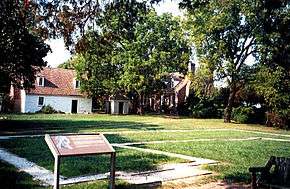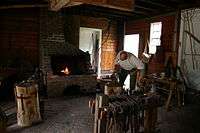George Washington Birthplace National Monument
| George Washington Birthplace National Monument | |
|---|---|
|
IUCN category V (protected landscape/seascape) | |
 | |
  | |
| Location | Westmoreland County, Virginia, United States |
| Nearest city | Colonial Beach, VA |
| Coordinates | 38°11′10″N 76°55′50″W / 38.18611°N 76.93056°WCoordinates: 38°11′10″N 76°55′50″W / 38.18611°N 76.93056°W |
| Area | 661.7 acres (267.8 ha)[1] |
| Established | January 23, 1930 |
| Visitors | 130,647 (in 2011)[2] |
| Governing body | National Park Service |
| Website | |
|
George Washington Birthplace National Monument | |
  | |
| NRHP Reference # | 66000850[3] |
| VLR # | 096-0026 |
| Significant dates | |
| Added to NRHP | October 15, 1966 |
| Designated VLR | October 18, 1983[4] |
The George Washington Birthplace National Monument is in Westmoreland County, Virginia, United States. This site was established in the 17th century as a colonial plantation by Englishman, John Washington, George Washington's great-grandfather. George Washington was born here on February 22, 1732. He lived here until age three, returning later to live here as a teenager.
The foundation outline of Washington's house are marked and nearby a memorial house was built in 1931 in historicist style to represent and educate about the plantation period. At the entrance to the grounds, now maintained and operated by the National Park Service, is a Memorial Shaft obelisk of Vermont marble, which is a one-tenth scale replica of the Washington Monument in Washington, D.C.
The monument and its preceding plantation, which eventually became called Wakefield, are located where Popes Creek joins the Potomac River, and is representative of 18th-century Virginia tobacco farms. The park's farm buildings, groves of trees, livestock, gardens, and crops of tobacco and wheat, represent the boyhood environment Washington knew.[5] The public park was established in 1930 and opened in 1932.
History

17th–18th centuries
George Washington's great-grandfather settled this plantation in 1657 at the original property on Bridges Creek.[6] The family acquired expanded land to the south toward nearby Popes Creek where the first section of the house in which George Washington was born was built before 1718 and enlarged by his father between 1722–1726. It was further enlarged by the mid-1770s to a ten-room house, known as "Wakefield". This house, which George Washington in 1792 would describe as "the ancient mansion seat,"[7] was destroyed by fire and flood on Christmas Day, 1779, and never rebuilt.[5]
Thirty-two graves of Washington family members have been found at the Bridges Creek cemetery plot, including George's half-brother, father, grandfather, and great-grandfather.
Washington's father cultivated tobacco on his several plantations, which was labor-intensive, involving the work of enslaved Africans and African Americans. By the time George Washington was born, the population of the Virginia colony was 50 percent black, most of whom were enslaved. "20 or so" slaves worked on the small tobacco farm at Popes Creek, during the time that Washington lived there.[8]

19th century
ln 1858, the Commonwealth of Virginia acquired the property to preserve the homesite and cemetery, but the Civil War intervened. Virginia donated the land to the Federal Government in 1882.
20th century
The Wakefield National Memorial Association was formed in 1923 to restore the property. In 1930, the grounds were authorized as a U.S. National Monument and, in 1931, the Wakefield Association received a grant from John D. Rockefeller, Jr. to acquire and transfer a total of 394 acres (1.59 km2) of land to the Federal government.
Since the exact appearance of the original Washington family home is not known, a Memorial House was designed by Edward Donn, Jr., representing similar buildings of the era and constructed on the approximate site in 1931. The actual location of Washington's boyhood home is adjacent to the memorial house and its foundation is outlined in the ground by crushed oyster shells.
Constructed as a memorial to George Washington in 1930–1931, the Memorial House is not an exact replica of his birthplace. Rather, it represents a typical upper-class house of the period. The Memorial House is constructed of bricks handmade from local clay. It has a central hallway and four rooms on each floor, furnished in the 1730–1750 period style by the Wakefield National Memorial Association. A tea table is believed to have been in the original house. Most of the other furnishings are more than 200 years old.[5]
The park and Memorial House were opened by the National Park Service in 1932, on the 200th anniversary of George Washington's birth.
The National Monument today


In the 21st century, the Monument is part of the National Park Service's ongoing efforts to interpret historical resources.[9] In addition to the Memorial House, park facilities open to visitors include the historic birthplace home area, Kitchen House, hiking trails, and picnic grounds. In the Kitchen House, costumed re-enactors demonstrate candle- and soap-making.[5] A Colonial Herb and Flower Garden, having plants common to Washington's time, such as thyme, sage, basil, and other herbs, flowers such as hollyhocks, forget-me-nots, and roses, as well as trees and bushes that date to Washington's time, may be viewed. The Colonial Living Farm, with a barn and pasture, raises livestock, poultry, and crops of the 18th century variety, using farming methods common then.
Visitors may also tour the Washington family Burial Ground, which contain the graves of 32 members of the Washington family, including George Washington's father, grandfather, and great-grandfather. Replicas of two original gravestones, along with five memorial tablets placed here in the 1930s, may be viewed.
The Visitors' Center contains artifacts recovered from the burned-down Washington house, such as those pictured at right (clockwise, from right): a bowl, clay figurine, wine bottle seal belonging to Augustine Washington, wine bottle, and keyhole plate.
A 15-minute film depicting Washington family life is shown in a theater at the Visitors' Center.
Directions

The George Washington Birthplace National Monument is 38 miles (61 km) east of Fredericksburg, Virginia, located on Virginia State Route 204, the access road to the site from Virginia State Route 3.
Stratford Hall Plantation, the birthplace of Robert E. Lee, and the town of Montross are nearby.
See also
- Northern Neck George Washington Birthplace AVA
- Montross, Virginia
- National Park Service
- Stratford Hall Plantation
- State Route 204, the access road to the site from State Route 3
References
- ↑ "Listing of acreage as of December 31, 2011". Land Resource Division, National Park Service. Retrieved 2012-05-14.
- ↑ "NPS Annual Recreation Visits Report". National Park Service. Retrieved 2012-05-14.
- ↑ National Park Service (2010-07-09). "National Register Information System". National Register of Historic Places. National Park Service. Retrieved 2013-07-16.
- ↑ "Virginia Landmarks Register". Virginia Department of Historic Resources. Retrieved 5 June 2013.
- 1 2 3 4 George Washington Birthplace, National Park Service brochure (1999)
- ↑ Marquis, A.N. Company. Who's Who In America, vol. 1:Historical Volume (1607-1896), revised ed., Marquis, A.N. Company., 1967.
- ↑ Washington, George, Writings, XXXII, p. 29
- ↑ "Slavery at Popes Creek Plantation", George Washington Birthplace National Monument, National Park Service, accessed 15 Sept 2011
- ↑ Seth C. Bruggeman, Here, George Washington Was Born: Memory, Material Culture, and the Public History of a National Monument (Athens: University of Georgia Press, 2008).
- Gary W. Ferris (1999), Presidential Places
External links
| Wikimedia Commons has media related to George Washington Birthplace National Monument. |
- George Washington Birthplace National Monument official website
- Wakefield, State Route 204, Wakefield Corner, Westmoreland County, VA: 15 photos, 3 data pages, and 2 photo caption pages at Historic American Buildings Survey
- Wakefield, Kitchen, State Route 204, Wakefield Corner, Westmoreland County, VA: 7 photos and 1 photo caption page at Historic American Buildings Survey
- Wakefield, Gardens & Grounds, State Route 204, Wakefield Corner, Westmoreland County, VA: 2 photos at Historic American Buildings Survey

